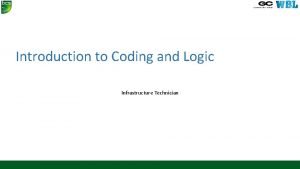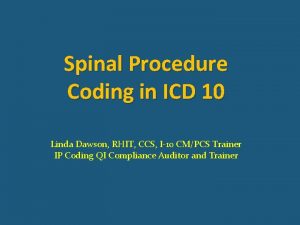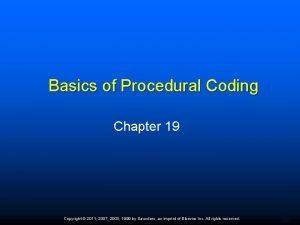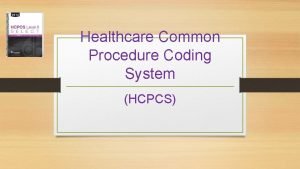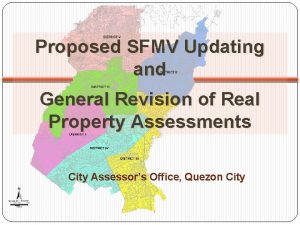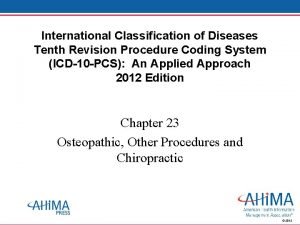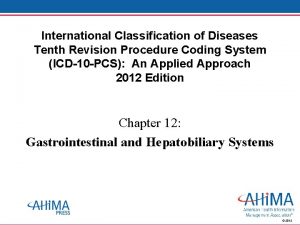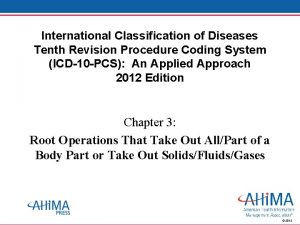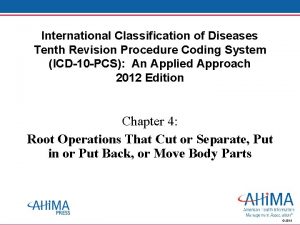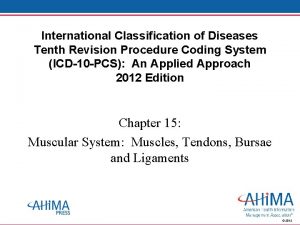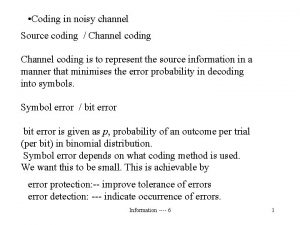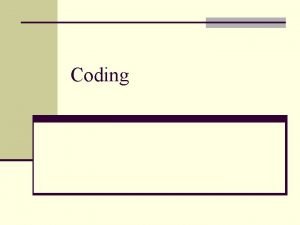International Classification of Diseases Tenth Revision Procedure Coding













- Slides: 13

International Classification of Diseases Tenth Revision Procedure Coding System (ICD-10 -PCS): An Applied Approach 2012 Edition Chapter 9: Sense Organs © 2013

Sense Organs • Eye – sends visual images to the brain for interpretation as pictures • Ear- sends sound waves to the brain • Nose – sends messages regarding airborne material. Also assists with sense of taste • Body system – 2 nd character -8 - Eye -9 – Ear, Nose and Sinus © 2012

Anatomy Review-Ocular System • Anterior cavity -Anterior Chamber -Posterior Chamber • • Posterior cavity Aqueous humor Vitreous Body See Figure 9. 1 © 2012

Ocular Structures • Ocular muscles -See Figure 9. 2 -ICD-10 -PCS classifies all eye muscles to extraocular muscles body part • Orbital structures -Lacrimal gland -See Figure 9. 3 © 2012

Anatomy Review- Ear • External ear – auricle -Pinna, ear lobe -External auditory canal • Middle ear -Eardrum -Ossicles one body part in ICD-10 -PCS • Malleus, incus and stapes -Air cells • Inner ear • See Figure 9. 4 © 2012

Anatomy Review - Nose • Nasal turbinates or conchae • Paranasal (accessory) sinuses -Ethmoid -Frontal -Maxillary -Sphenoid • See Figure 9. 5 and Figure 9. 6 © 2012

Common Root Operations • Alteration-for cosmetic purposes • Dilation, Occlusion, Restriction-tubular body parts • Extraction-lens removal only • Replacement-lens removal with IOL, cornea transplant © 2012

Common Root Operations (continued) • • • Repair-radial keratotomy Drainage-tympanoplasty, myringotomy Excision- removal of one ossicle Resection – removal of all three ossicles Inspection – diagnostic sinus endoscopy See Table 9. 1 © 2012

Body Part Values • External ear • Inner ear -Oval window -Semicircular canal • Bony labyrinth • Bony vestibule -cochlea • See Table 9. 2 © 2012

Approaches Used for the Sense Organs • 0 – Open • 3 – Percutaneous • 4 – Percutaneous endoscopic (ear, nose and sinus only) • 7 – Via natural or artificial opening • 8 –Via natural or artificial opening, endoscopic • X - External © 2012

Devices for the Sense Organs • 0 – Synthetic Substitute -EG Intraocular telescope, Implantable miniature telescope (IMT) for age-related macular degeneration • B - Intraluminal device -EG Nasal trumpet, nasopharyngeal airway (NPA) © 2012

Hearing Devices • Cochlear prostheses • Bone conduction device • Combination devices -Receptors in inner ear -External hearing device on or in temporal bone • See Table 9. 4 © 2012

Qualifiers Used in the Sense Organs • Bypass end point -Eye • Nasal cavity • Sclera -Ear • endolymphatic -X – Diagnostic -Z - No Qualifier © 2012
 Contoh open coding axial coding selective coding
Contoh open coding axial coding selective coding Open coding
Open coding Passive progressive
Passive progressive Coding and logic revision
Coding and logic revision Axial coding vs open coding
Axial coding vs open coding Coding dna and non coding dna
Coding dna and non coding dna Tethered spinal cord icd 10
Tethered spinal cord icd 10 Chapter 19 procedural coding
Chapter 19 procedural coding The healthcare common procedure coding system
The healthcare common procedure coding system Periradicular
Periradicular General revision of assessments and property classification
General revision of assessments and property classification The tenth man graham greene summary
The tenth man graham greene summary 695 round off to the nearest hundreds
695 round off to the nearest hundreds Campbell biology tenth edition
Campbell biology tenth edition



